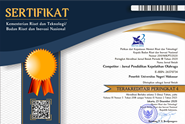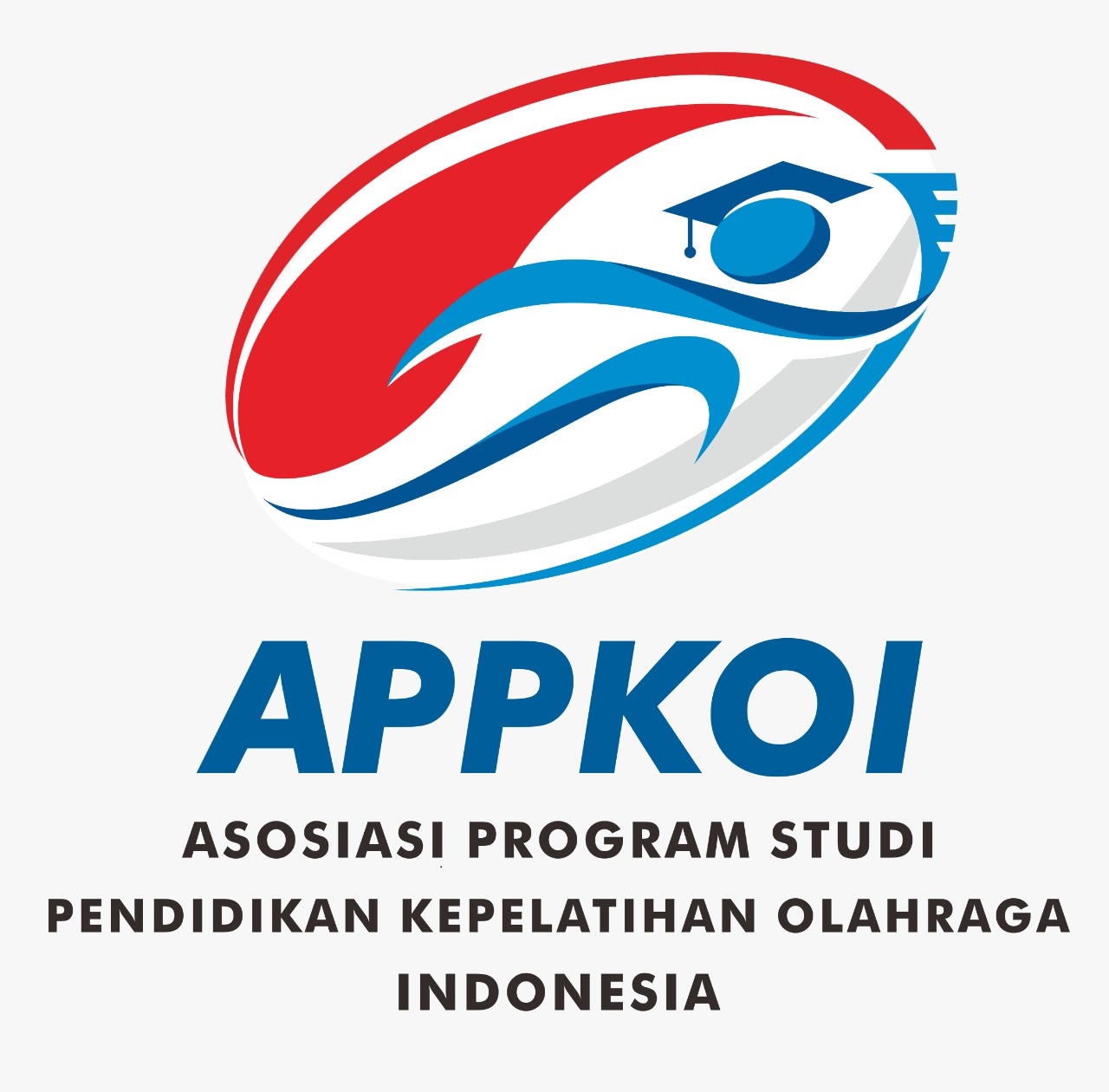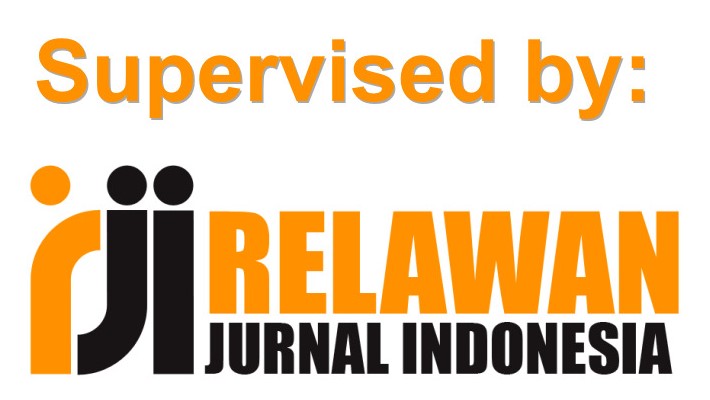The Methods of Uphill Sprint and Downhill Sprint Training Against 100 Meters Running Speed Viewed From the Strength of the Leg Muscles in son Athletes
(1) Nusantara PGRI Kediri University
(2) Nusantara PGRI Kediri University
(3) Nusantara PGRI Kediri University
(*) Corresponding Author
DOI: https://doi.org/10.26858/cjpko.v14i3.38870
Abstract
The purpose of this study is to find the truth about: (1) To find out the difference in the influence between the Uphill sprint and Downhill Sprint training methods on the improvement of 100-meter sprint achievement. (2) To find out the difference in the improvement of 100-meter sprint achievement between students who have high and low leg muscle strength. (3) To determine the effect of the interaction between the Uphill sprint and Downhill Sprint training methods with the strength of the high and low leg muscles on the improvement of the 100-meter sprint performance. Experimental method in one group without comparison using pretest-posttest design. The population of this study was athletes from SMP Negeri 1 Rejoso, Nganjuk Regency, class VIII. The sample size used in this study was 32 Men athletes. The sampling technique in this study was Purposive random sampling. The variables studied are free variables consisting of two reactors, namely manipulative variables and attributive variables and one dependent variable. Manipulative variables have two treatments, including giving Uphill sprint exercises, and Downhill sprints. While the attributive variable in this study is the strength of the leg muscles which are distinguished by high and low. The dependent variable of the study is the increase in sprints of 100 meters. Data collection techniques with tests and measurements, leg muscle strength data with leg and back dynamometers. The data analysis techniques used for hypothesis testing are the 2-lane design Variance Analysis (ANOVA) and the Newman-Keuls range test, at a significance level of 95%. The results of the study that Uphill sprint training has a different improvement from Downhill sprint training. From the calculation results obtained Fhit = 12.5641 greater than Ftabel = 2.95 (F0 > Ft) at a signification level of 5%. This means that the null hypothesis (Ho) is rejected. This means that the Uphill sprint practice has different improvements than the Downhill sprint practice is acceptable. The results of this study showed that players who had low leg muscle strength had a 100-meter sprint increase which was different from players who had high leg muscle strength. This is evidenced by the value of Fhit = 4.2619 greater than Ftabel = 2.95 (F0 > Ft) at a signification level of 5%. This means that the null hypothesis (H0) is rejected. This means that athletes who have low leg muscle strength have a 100-meter sprint that is different from high leg muscle strength players, it is acceptable. The results of this study also showed that there was an interaction between the influence of plyometric exercise and a significant level of leg muscle strength, which was shown by F0 = 23.4810 greater than Ft = 2.95 at a signification level of 5% so that H0 was rejected, so it can be concluded that there was a significant interaction between the influence of plyometric exercise and the level of leg muscle strength. Players who have low leg muscle strength are more appropriately given the Uphill sprint training treatment to increase the sprint by 100 meters. Downhill sprint training treatment is more appropriately given to athletes who have high leg muscle strength.
Keywords
Full Text:
PDFReferences
Bagia, I. M. (2015). Pelatihan Lari Akselerasi Jarak 40 Meter 10 Set dan 50 Meter 8 Set Terhadap Peningkatan Kecepatan Lari Siswa Putra Kelas VII SMP Ganesha Denpasar. International Journal of Soil Science, 1(2), 96–105. https://ojs.ikippgribali.ac.id/index.php/jpkr/article/view/249
Balsalobre-Fernández, C., Tejero-González, C. M., Del Campo-Vecino, J., & Alonso-Curiel, D. (2013). The effects of a maximal power training cycle on the strength, maximum power, vertical jump height and acceleration of high-level 400-meter hurdlers. Journal of Human Kinetics, 36(1), 119–126. https://doi.org/10.2478/hukin-2013-0012
Bompa, T. (2012). Annual Planning , Periodisation and Its Variations. FISA Coaching Development Programme.
Bompa, T. O., & Haff, G. G. (2009). Periodization: Theory and Methodology of Training. 5th ed. In Champaign, Ill. : Human Kinetics;
Budiwanto, S. (2012). Metodologi Latihan Olahraga. In FIK Universitas Negeri Malang.
Cahyono, I. T., Sugiarto, T., & Amiq, F. (2017). Pengaruh Latihan Ladder Drill Terhadap Peningkatan Kecepatan Lari Peserta Ekstrakurikuler Sepakbola SMA. Gelanggang Pendidikan Jasmani Indonesia, Jurusan Pendidikan Jasmani Dan Kesehatan, Fakultas Ilmu Keolahragaan, Universitas Negeri Malang, 1(2), 282–290. https://doi.org/http://dx.doi.org/10.17977/um040v1i2p282-290
Fadillah. (2009). Kenapa Atletik Disebut Induk Semua Cabang Olahraga. Buana Citra Publisher.
Faizah, A. (2016). Analisis Gerak Akselerasi Sprint 100 Meter (Studi pada Atlet Lari Sprint 100 Meter Putra Pelatnas B, Ditinjau dari Aspek Biomekanika). Jurnal Sporta Saintika, 1(2), 1–10. https://doi.org/https://doi.org/10.24036/sporta.v1i2.34
Farida, A. (2016). Urgensi Perkembangan Motorik Kasar Pada Perkembangan Anak Usia Dini. Jurnaltarbiyah.Uinsu.Ac.Id, IV(2).
Ferry, M. W., & Welis, W. (2019). Hubungan Kadar Hemoglobin Terhadap Kemampuan VO2 Max Pada Pemain Sekolah Sepkabola (SSB) Tunas Inti Kecamatan Sungai Bungkal Kota Sungai Penuh. Jurnal Stamina, Jurusan Kesehatan Dan Rekreasi Fakultas Ilmu Keolahragaan Universitas Negeri Padang, 2(1), 425–436. https://doi.org/https://doi.org/10.24036/jst.v2i1.77
Giyatno. (2017). Penerapan Latihan Akselerasi Untuk Meningkatkan Kecepatan Lari 100 Meter Pada Siswa Kelas IV di SD Negeri IV Giriwoyo. Jurnal Sportif, 3(1), 29–43. https://doi.org/https://doi.org/10.29407/js_unpgri.v3i1.615
Ishak, M., Asmawi, M., Tangkudung, J., Dlis, F., & Sahabuddin. (2022). Smash Training Model in Badminton Game in College Students of the Faculty of Sports Science, Makassar State University. International Journal of Science and Society, 4(2), 209–221. https://doi.org/10.54783/ijsoc.v4i2.463
Jaliusril, Asyar, R., & Harjono, H. S. (2012). Pengembangan Media Audia-Visual Pembelajaran Lari Jarak Pendek untuk Siswa SMP. Tekno-Pedagogi, Jurnal Teknologi Pendidikan, 2(1), 1–21. https://online-journal.unja.ac.id/pedagogi/article/view/1395
Johan Cahyo B., Musyafari Waluyo, S. R. (2012). Pengaruh Latihan Lompat Kijang Terhadap Kecepatan Lari. JSSF (Journal of Sport Science and Fitness), 1(1), 17–21. http://journal.unnes.ac.id/sju/index.php/jssf%0APENGARUH
Juliyanto, O. D. (2016). Pengaruh Latihan Ladder Drill Icky Shuffle Terhadap Peningkatan Kecepatan. Jurnal Kesehatan, 7(3), 45–52. https://www.google.com/url?sa=t&rct=j&q=&esrc=s&source=web&cd=&cad=rja&uact=8&ved=2ahUKEwinwebxuv7pAhUWXisKHbhWBvkQFjAAegQIARAB&url=https%3A%2F%2Fjurnalmahasiswa.unesa.ac.id%2Findex.php%2Fjurnal-kesehatan-olahraga%2Farticle%2Fdownload%2F17838%2F16252&usg=
Kerlinger. (2006). Asas–Asas Penelitian Behaviour. Gadjah Mada University Press.
Nuryadi, A., & Firmansyah, G. (2018). Pengaruh Latihan Ladder Drill Terhadap Kecepatan Lari 60 Meter Pada Siswa Sekolah Bola Basket Loc Sidoarjo. JP.JOK (Jurnal Pendidikan Jasmani, Olahraga Dan Kesehatan), 2(1), 63–69. https://doi.org/10.33503/jpjok.v2i1.191
R., I. A. A., & Furkan, I. (2014). Perbedaan Pengaruh Metode Latihan Terhadap Peningkatan Prestasi Lari 100 Meter Ditinjau dari Rasio Panjang Tungkai dan Tinggi Badan. Penerapan IPTEK Dan Penguatan Ilmu Keolahragaan Dalam Mendukunug Prestasi Olahraga Nasional, 110–124. fik.um.ac.id/wp-content/uploads/2014/11/11.PROCEEDINGS-PERTEMUAN-ILMIAH-ILMU-KEOLAHRAGAAN-NASIONAL-2014-MALANG.Ika-Ahmad.pdf
Rahadian, A. (2018). Aplikasi Analisis Biomekanika Untuk Mengembangkan Kemampuan Lari Jarak Pendek (100 M) Mahasiswa PJKR UNSUR (Kinovea Software). Jurnal Maenpo, 8(1), 1–14. https://doi.org/https://doi.org/10.35194/jm.v8i1.912
Sahabuddin. (2017). Evaluation Program Regional Training Center (Pelatda) PON XIX South Sulawesi. JIPES, Journal of Indonesian Physical Education and Sport. Universitas Negeri Jakarta, 3(1), 85–99. https://doi.org/https://doi.org/10.21009/JIPES.031.011
Sahabuddin. (2020). Hubungan Koordinasi Mata Tangan, Kelincahan, Dan Keseimbangan Terhadap Kemampuan Dribble Bolabasket. JCE SPORTS: Journal Coaching Education Sport, 2(2), 133–144. https://doi.org/https://doi.org/10.31599/jces.v1i2.372
Sahabuddin, Bismar, A. R., & Ad’dien. (2020). Pengaruh Latihan Akselerasi Terhadap Kemampuan Lari 50 Meter. Jurnal SPEED, Program Studi Pendidikan Jasmani, FKIP, Universitas Singaperbangsa Karawang, 3(1), 51–57. https://doi.org/http://dx.doi.org/10.35706/jurnal%20speed.v3i1.3574
Satun. (2018). Peningkatan Hasil Belajar Lari Cepat 100 M Melalui Metode Latihan Akselerasi. Jurnal Pendidikan: Riset & Konseptual, 2(1), 24–29. https://doi.org/https://doi.org/10.28926/riset_konseptual.v2i1.19
Sudirman, Syahruddin, & Sahabuddin. (2022). Tingkat Keterampilan Gerak Dasar Sepakbola Pada Siswa SMA Negeri 2 Majene. JOKER, Jurnal Olahraga Kebugaran Dan Rehabilitasi, 2(1), 43–52. https://doi.org/https://doi.org/10.35706/joker.v2i1.6479
Sugito, S., Allsabah, M. A. H., & Putra, R. P. (2020). Manajemen kepelatihan klub renang Kota Kediri tahun 2019. Jurnal SPORTIF : Jurnal Penelitian Pembelajaran. https://doi.org/10.29407/js_unpgri.v6i1.14021
Sugiyono. (2012). Statistik Untuk Pendidikan. In Statistika Untuk Penelitian.
Sukadiyanto. (2005). Pengantar Teori Dan Melatih Fisik. FIK Uiversitas Negeri Yogyakarta.
Sukadiyanto. (2011). Tori dan Metodologi Melatih Fisik. In Bandung: Lubuk Agung.
Taufik Hidayat, Ramadi, A. J. (2016). Pengaruh Latihan Koordinasi Berlari Dengan Lutut Tinggi dan Diiukuti Dengan Sprint Terhadap Kecepatan Lari 50 M Pada Atlit Sprint 100 M PPLP Riau. Jurnal Online Mahasiswa Fakultas Keguruan Dan Ilmu Pendiidkan Universitas Riau, 1–12. https://www.neliti.com/publications/200326/pengaruh-latihan-koordinasi-berlari-dengan-lutut-tinggi-dan-diikuti-dengan-sprin
Umah, R. T., Raharjo, S., & Adi, S. (2016). Pengaruh Latihan Pliometric Skipping dan Split Jump Terhadap Hasil Kecepatan Lari Sprint 60 Meter Untuk Peserta Ektrakurikuler Usia 15-17 Tahun di SMAN 1 Turen. Jurnal Sport Science, 6(2), 1–13. http://journal2.um.ac.id/index.php/sport-science/article/view/5268
Article Metrics
Abstract view : 130 times | PDF view : 24 timesRefbacks
- There are currently no refbacks.
Copyright (c) 2022 Kuncoro Hadi Kusumo, Wasis Himawanto, Sulistiono Sulistiono

This work is licensed under a Creative Commons Attribution 4.0 International License.
COMPETITOR IS LICENSED BY :
 COMPETITOR is licensed under a Creative Commons Attribution 4.0 International License.
COMPETITOR is licensed under a Creative Commons Attribution 4.0 International License.
COMPETITOR EDITORIAL LOCATION :
![]() Kampus FIK Banta Bantaeng, Jalan Wijaya Kusuma Nomor 14, Rappocini, Makassar, Postal Code 90222
Kampus FIK Banta Bantaeng, Jalan Wijaya Kusuma Nomor 14, Rappocini, Makassar, Postal Code 90222
COMPETITOR IS INDEXED BY















